The Unstoppable Rise of Nursing: How AI, Robotics and Automation Are Empowering the Future of Nursing 2025
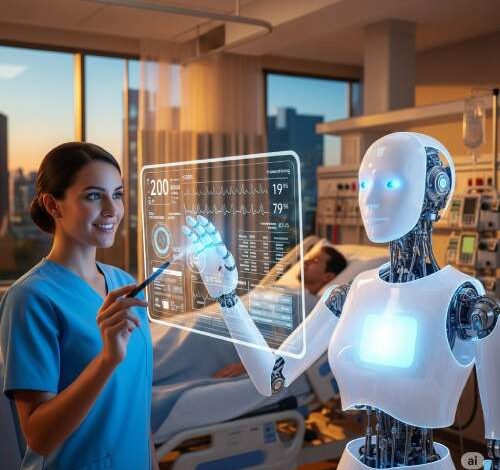
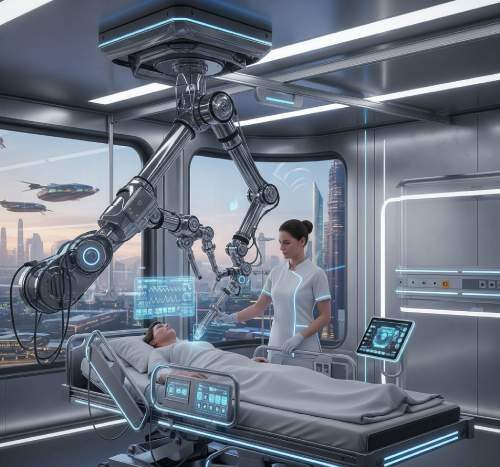
The Paradigm Shift: Understanding the Core Role of AI in Nursing Today
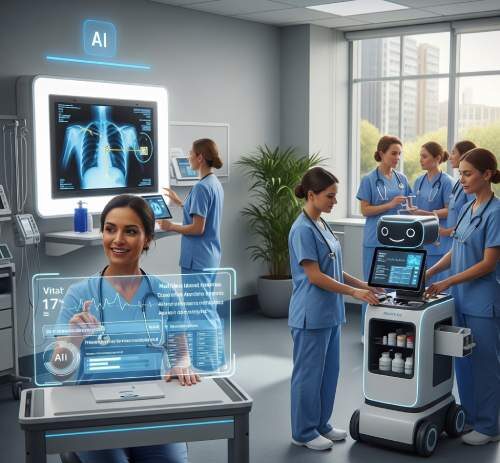 The integration of artificial intelligence into healthcare is fundamentally changing the way nurses work. No longer confined to the realm of science fiction, AI in nursing has become a practical reality, offering new ways to improve patient outcomes, enhance clinical decision-making, and manage the growing complexities of the healthcare landscape. The shift is from reactive care to proactive care, and AI is the engine driving this change.
The integration of artificial intelligence into healthcare is fundamentally changing the way nurses work. No longer confined to the realm of science fiction, AI in nursing has become a practical reality, offering new ways to improve patient outcomes, enhance clinical decision-making, and manage the growing complexities of the healthcare landscape. The shift is from reactive care to proactive care, and AI is the engine driving this change.
1. The Power of Predictive Analytics: Foresight in Patient Care
One of the most impactful applications of AI is its ability to analyze vast amounts of patient data to predict potential health issues. AI-powered clinical decision support systems examine electronic health records, vital signs, lab results, and patient history in real-time. By recognizing subtle patterns that might be invisible to the human eye, these algorithms can generate early warnings for conditions such as sepsis, cardiac arrest, or patient falls. This foresight allows nurses to intervene proactively, often preventing a medical emergency before it escalates. For example, a traditional early warning score might rely on a limited set of vital signs, but an AI-driven system can process hundreds of data points simultaneously, leading to more accurate and timely alerts. This is not about a machine replacing a nurse’s judgment; it’s about providing the nurse with a powerful co-pilot, a second set of eyes that is tirelessly monitoring every detail.2. Streamlining Workflows with Automation in Healthcare
The sheer volume of administrative tasks—charting, medication management, scheduling, and documentation—is a significant contributor to nursing stress and burnout. This is where automation steps in as a game-changer. By automating these repetitive, non-clinical tasks, technology is liberating nurses to focus on what matters most: direct patient interaction.- Automated Documentation: Smart systems can transcribe spoken notes, auto-fill forms based on real-time data, and even suggest relevant entries, dramatically reducing the time a nurse spends on charting.
- Medication Management: Automated dispensing systems and smart IV pumps reduce the risk of medication errors. AI algorithms can help with dose calculations and cross-check for potential drug interactions, adding another layer of safety.
- Resource Management: AI can optimize staffing schedules, predict patient census fluctuations, and even manage inventory, ensuring nurses have the necessary resources and aren’t burdened with unnecessary administrative work.
Robotics and Automation Are Empowering the Future of Nursing 2025
The Robotic Revolution: Redefining the Hands-On Aspect of Nursing
While AI handles the data, robotics are taking on a more tangible role, performing physical tasks that assist nurses and improve patient care. The robotics in nursing trend is about leveraging machines to perform tasks that are either dangerous, physically strenuous, or repetitive, thereby allowing nurses to dedicate their time and expertise to more complex patient needs.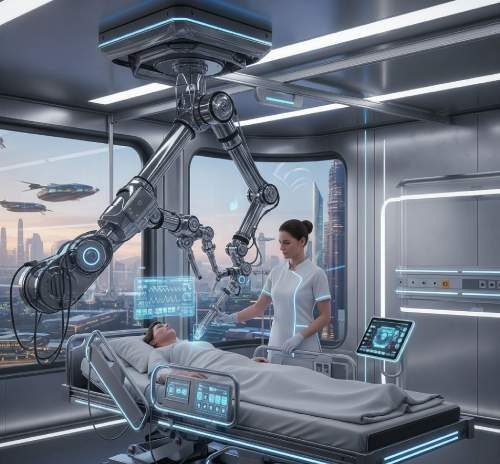
1. Assisting with Patient Mobility and Physical Tasks
Patient handling—lifting, turning, and ambulating—is a leading cause of musculoskeletal injuries for nurses. Robotic assistants are being designed specifically to address this challenge.- Patient Lifts: Automated lift systems can safely move patients from bed to chair, reducing the physical strain on nurses and decreasing the risk of injury for both the patient and the provider.
- Rehabilitation Robots: These devices assist patients with physical therapy, guiding them through exercises and providing real-time feedback. This frees up the nurse to oversee the patient’s progress and provide emotional support rather than manually assisting with every repetition.
- Medication and Supply Delivery: Autonomous mobile robots (AMRs) are now a common sight in many hospitals, transporting medications, lab samples, and linens from one department to another. This simple act of automation saves nurses countless hours of walking and fetching supplies, allowing them to remain on their unit with their patients.
2. AI-Powered Virtual and Augmented Reality in Nursing Education
The future of nursing education is also being reshaped by AI and robotics. These technologies provide immersive, risk-free environments for students to learn and practice critical skills.- Virtual Reality (VR) Simulations: AI-driven VR simulations allow students to practice clinical skills like IV insertion, wound care, or even responding to a code blue. The AI can provide real-time feedback on technique, ensuring students master procedures before ever touching a real patient.
- Augmented Reality (AR): AR overlays can display a patient’s vital signs or medical history directly onto a nurse’s field of view, providing instant access to critical information during a procedure. This is a game-changer for new nurses, who can be overwhelmed by the amount of information they need to process.
Addressing the Human-Machine Relationship: The Ethical and Practical Challenges
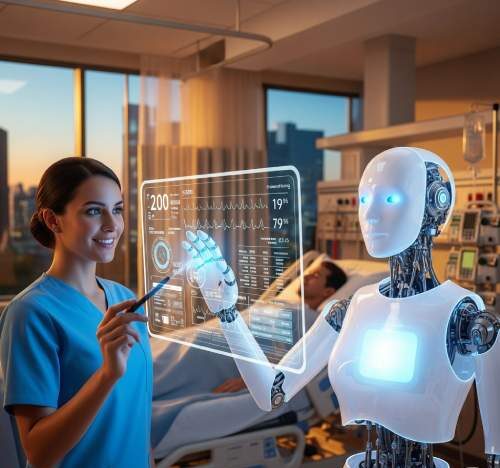 The integration of these technologies is not without its challenges. The success of AI in nursing and automation in healthcare depends on our ability to navigate a complex landscape of ethical considerations, technical hurdles, and the need for significant workforce adaptation.
The integration of these technologies is not without its challenges. The success of AI in nursing and automation in healthcare depends on our ability to navigate a complex landscape of ethical considerations, technical hurdles, and the need for significant workforce adaptation.
1. The Ethical Framework for AI in Nursing
The ethical implications of relying on technology in patient care are paramount.- Data Privacy and Security: AI systems require access to vast amounts of sensitive patient data. Ensuring this information is protected from breaches and misuse is a non-negotiable priority. Robust cybersecurity measures and clear data governance policies are essential.
- Algorithmic Bias: AI models are only as good as the data they are trained on. If the data is biased—for example, if it underrepresents certain populations—the AI’s recommendations may also be biased, leading to disparities in care. Nurses must be educated to recognize these biases and use their clinical judgment to override flawed recommendations.
- Accountability: If an AI system makes a mistake, who is responsible? Is it the nurse who followed the recommendation, the developer who coded the algorithm, or the hospital that implemented the technology? Clear frameworks for accountability must be established to protect both nurses and patients.
2. Bridging the Skills Gap: Preparing the Nursing Workforce for the Future
The future of nursing requires a new skill set. The modern nurse must be both a compassionate caregiver and a tech-savvy professional.- Digital Literacy: Nursing curricula must evolve to include comprehensive training in digital health technologies, including electronic health records, telemedicine platforms, and the fundamentals of AI.
- Data Interpretation: Nurses need to be able to understand and interpret the data provided by AI systems. This requires a shift from simply collecting data to critically analyzing it and integrating it into their clinical practice.
- Critical Thinking and Ethical Reasoning: As technology automates more routine tasks, the nurse’s role will shift toward more complex patient management, ethical decision-making, and emotional support. The ability to critically evaluate AI recommendations and apply sound ethical reasoning will become more important than ever.
From Bedside to a Connected Ecosystem: The Future of Nursing Beyond the Hospital Walls
The impact of AI in nursing and automation in healthcare extends far beyond the traditional hospital setting. These technologies are enabling a more holistic, connected, and patient-centered model of care that is accessible from anywhere.1. Telehealth and Remote Patient Monitoring
The rise of telehealth and remote patient monitoring has transformed care delivery, and it would not be possible without AI. AI-powered platforms can analyze data from wearable sensors and remote monitoring devices to alert nurses to changes in a patient’s condition. For example, an AI system can track a patient’s blood pressure, heart rate, and activity levels from their home and flag a nurse if the data indicates a potential issue. This allows for early intervention and prevents unnecessary hospitalizations. The nurse’s role in this new landscape is that of a care coordinator, a digital navigator who uses technology to manage a cohort of patients remotely, providing guidance and support through video calls, secure messaging, and personalized care plans. This model of care is especially vital in managing chronic diseases and providing healthcare to rural or underserved populations.2. The Role of Robotics in Elder Care and Home Health
As the global population ages, the demand for elder care is skyrocketing. Robots are emerging as a powerful solution to augment home health services.- Companionship Robots: These robots can engage with elderly individuals in conversation, play games, and provide medication reminders, helping to combat loneliness and ensure adherence to care plans.
- Monitoring Robots: Robots equipped with sensors can monitor for falls, detect changes in a person’s behavior, and alert a caregiver or family member to a potential problem, providing a layer of security and peace of mind.
- Physical Assistance: Some robots can assist with simple physical tasks, such as fetching a glass of water or retrieving a dropped item, preserving the independence of the elderly while reducing the burden on caregivers.
Conclusion: The New Dawn of Nursing
The journey toward a technology-integrated future is well underway. AI in nursing, robotics, and automation are not a threat to the profession but a catalyst for its evolution. By embracing these tools, nurses are no longer just caregivers; they are becoming data interpreters, ethical navigators, and architects of a more efficient and compassionate healthcare system. The shift is clear:- From reactive care to proactive, predictive care.
- From administrative burden to streamlined efficiency.
- From physical strain to a safer, more sustainable work environment.
- From isolated care to a connected, holistic ecosystem.
External Resources
1. Artificial Intelligence in Healthcare
-
World Health Organization (WHO) – Ethics and Governance of Artificial Intelligence for Health
-
National Institutes of Health (NIH) – AI in Healthcare Research
-
Nature Medicine – Applications of Artificial Intelligence in Clinical Practice
2. Robotics in Nursing
-
International Federation of Robotics (IFR) – Robots in Healthcare
-
Nursing Times – Robotics and the Future of Nursing
-
American Nurses Association (ANA) – Technology and Nursing Practice
3. Automation in Healthcare
-
Healthcare Information and Management Systems Society (HIMSS) – Automation in Healthcare
-
HealthTech Magazine – How Automation is Changing Healthcare Operations
-
McKinsey & Company – Automation in Healthcare Operations
FAQs
The article highlights several ethical challenges, including ensuring patient data privacy and security, addressing algorithmic bias (where AI recommendations may be skewed due to biased training data), and establishing clear frameworks for accountability if an AI system makes a mistake.
AI is being used to create immersive learning experiences for nursing students through virtual reality (VR) and augmented reality (AR) simulations. These technologies allow students to practice clinical skills in a risk-free environment and receive real-time feedback, preparing them for real-world scenarios.
By automating repetitive and stressful tasks like documentation and resource management, these technologies help reduce administrative burdens and physical strain. This leads to a more efficient and less stressful work environment, which can significantly improve a nurse’s overall mental health and job satisfaction.
The article explains that AI and robotics enable better remote patient monitoring and elder care. AI-powered platforms can track a patient’s health data from home, and robots can assist with simple tasks, provide companionship, and monitor for falls, extending the reach of care beyond the hospital walls.




2 Comments